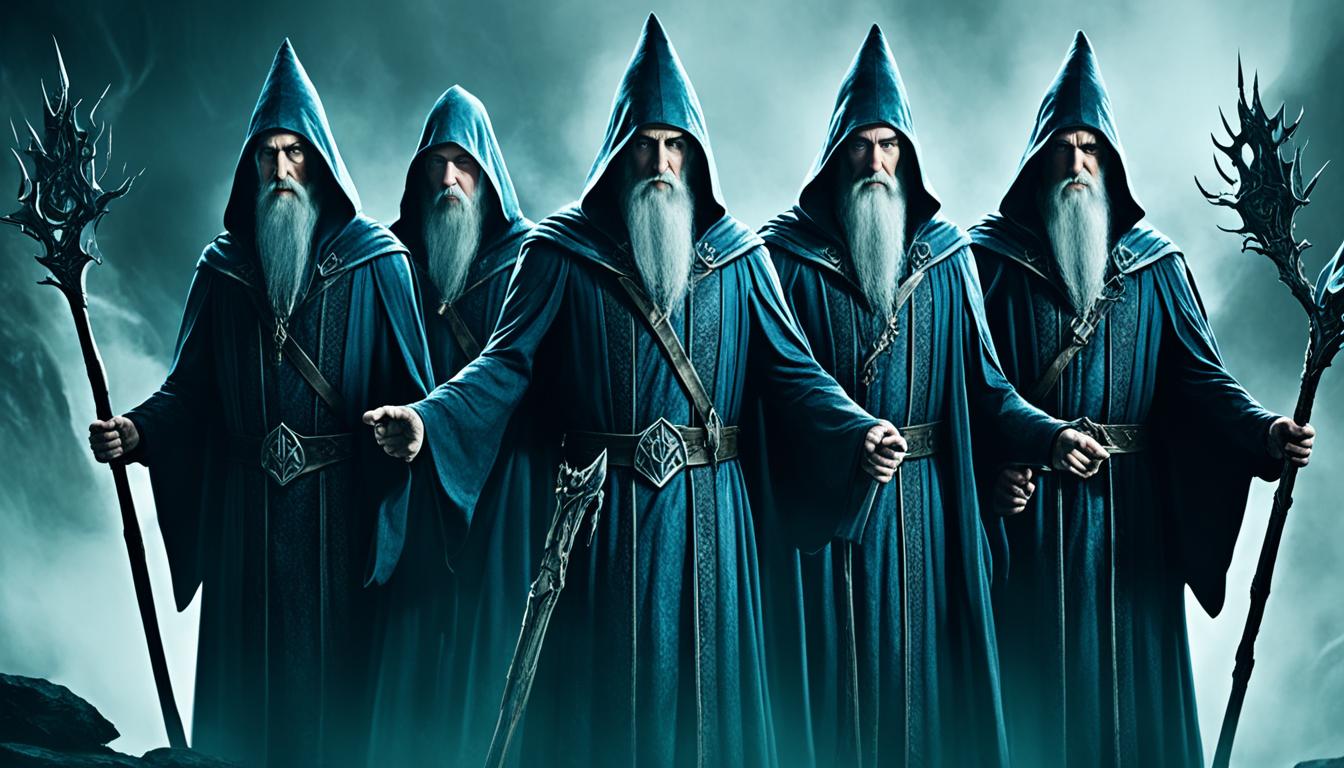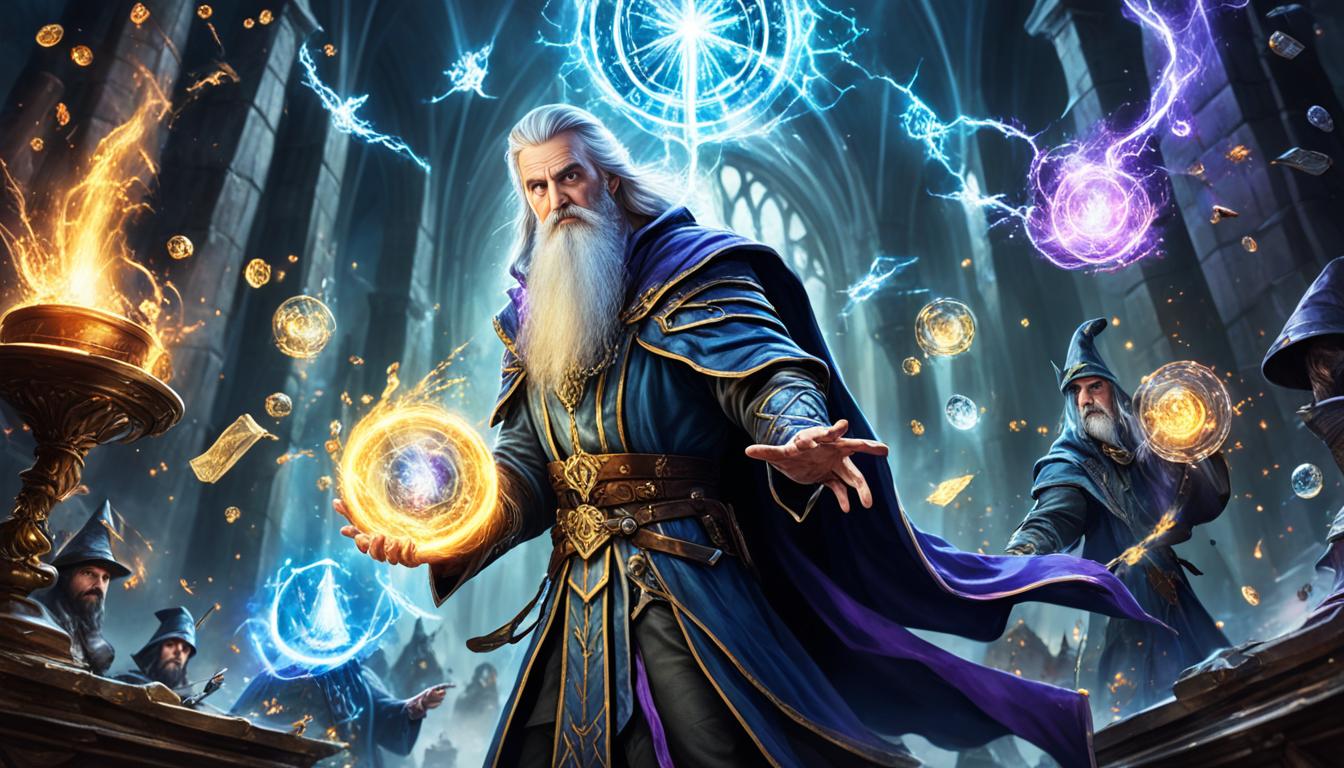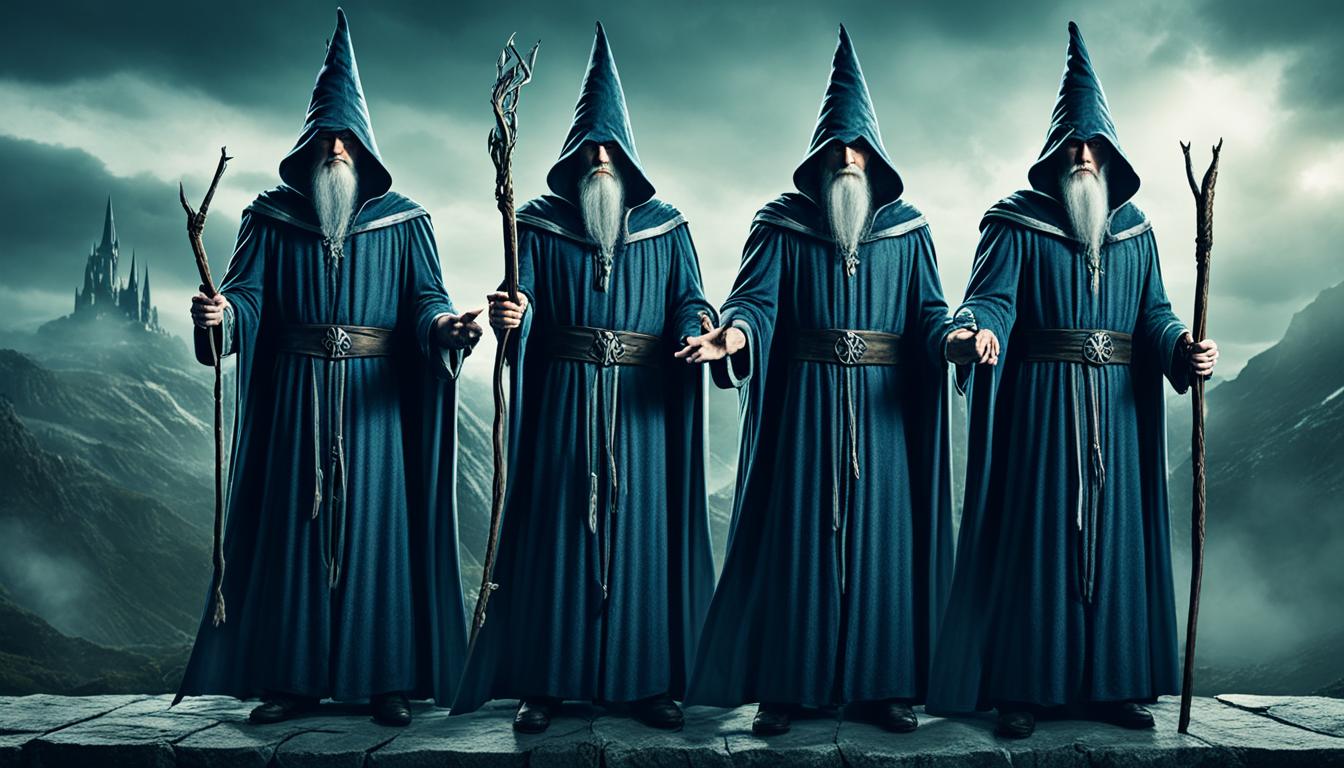Mirror Image 5e: Unveil the Spells Secrets!
When it comes to defensive spells in Dungeons and Dragons 5th edition, Mirror Image is at the top of my list. This powerful illusion spell is a game-changer when it comes to protecting yourself from enemy attacks. By creating illusory duplicates of yourself, Mirror Image makes it incredibly difficult for enemies to hit their target accurately. It is a spell that can turn the tides of battle in your favor.
As a wizard, I have always been drawn to illusion spells, and Mirror Image never disappoints. This spell, found in the Player’s Handbook, allows me to confuse and confound my enemies, giving me precious moments to plan and strategize. The mechanics of Mirror Image are fascinating, and its strategic applications are endless.
To truly appreciate the power of Mirror Image, let’s do the math on it. The spell creates three illusory duplicates of yourself, making it appear as if there are four of you on the battlefield. When an enemy tries to attack you, they must choose which target is the real one, and there is a 1 in 4 chance that they hit an illusion instead. This effectively reduces the likelihood of you being hit by 75%. With each attack, the chances of hitting an illusion remain the same, making Mirror Image a reliable and dependable defensive spell.
But Mirror Image is not without its limitations. The illusions created by the spell mimic your actions, so moving erratically or using clever tactics can further confuse your enemies. However, physical interactions, such as making an attack or casting a spell, reveal the real you. It is important to use Mirror Image strategically and not solely rely on it for defense.

Key Takeaways:
- Mirror Image is an illusion spell in D&D 5e that creates illusory duplicates of yourself to confuse enemies.
- By creating three duplicates, Mirror Image reduces the chance of being hit by 75%.
- Physical interactions, such as attacks or spells, reveal the real target of Mirror Image.
- Using Mirror Image in combination with other defensive spells and tactics can greatly enhance your survivability in combat.
Understanding Mirror Image in Dungeons and Dragons
Mirror Image 5e is a fascinating illusion spell in the world of Dungeons and Dragons. It allows the caster to create multiple duplicates of themselves, confusing enemies and granting a significant defensive advantage. In this section, we will delve into the mechanics, effects, and unique aspects of Mirror Image 5e, uncovering the secrets behind this powerful illusion spell.
What Is Mirror Image?
Mirror Image is an illusion spell that creates illusory duplicates of the caster, making it difficult for enemies to determine which one is the real target. When the spell is cast, three illusory images appear around the caster, mimicking their actions and movements. These duplicates move with the caster, creating a chaotic and confusing scene for opponents who attempt to attack.
This spell relies on deception and misdirection to enhance the caster’s defenses. By making it challenging for enemies to discern the real caster, Mirror Image 5e effectively confounds their attacks, increasing the chances of survival in combat.
History and Role of Illusion Spells in D&D
The history of illusion spells in Dungeons and Dragons dates back to the early incarnations of the game. Illusion spells have always played a pivotal role in creating a sense of mystery, deception, and the unexpected. These spells allow players to bend reality, confuse adversaries, and outwit their opponents through clever tactics and strategic thinking.
Illusion spells, including Mirror Image, are essential tools for spellcasters specializing in trickery and manipulation. They provide opportunities for creative problem-solving and role-playing, encouraging players to think outside the box and leverage the power of illusions to their advantage.
Throughout the history of D&D, illusion spells have remained a cornerstone of spellcasting, offering diverse and imaginative avenues for players to explore. From basic illusions to complex mind-altering effects, these spells add depth and excitement to the world of Dungeons and Dragons.
The Spellcasting Mechanics Behind Mirror Image 5e
When you first cast Mirror Image three illusionary duplicates pop up around you. These images move like you and around you in a “shell game” like manner, which according to the text of the spell make it “impossible to track which image is real”. As such the enemy is just as likely to hit an illusion as they are to hit you. When you are targeted by an attack, you first roll to see if the attack hits you or an illusion, the breakdown looks like this:
| Number of Duplicates | DC | Percentage Chance to Hit Image |
|---|---|---|
| 3 | 6 or better | 75% |
| 2 | 8 or better | 65% |
| 1 | 10 or better | 50% |
If an image gets hit, you lose that image but the great thing about this spell is the images have an AC. Each duplicate has an AC of 10 + your Dexterity modifier. How can an illusion have an AC you ask? Well, the illusions are constantly moving with you and around you. Since they are moving targets they are hard to hit.
Once you roll to determine if it was you or one of your images that was targeted, you then compare the attackers roll to the AC. There is a chance that they target one of your images and miss!
Breaking Down the Components and Casting Time
The casting of Mirror Image requires specific components, including verbal, somatic, and material components. The verbal component involves the incantation and recitation of arcane phrases, while the somatic component requires precise hand gestures and movements. As for the material component, it entails the use of a small mirror or silvered glass.
The casting time for Mirror Image is one action. This means that the spell can be cast quickly, allowing the caster to utilize it effectively during combat or other time-sensitive situations. The swift casting time of Mirror Image contributes to its versatility and tactical advantage on the battlefield.
Duration, Effects, and Limitations of the Spell
Once Mirror Image is successfully cast, it creates illusory duplicates of the caster that can confuse enemies and provide a defensive advantage. These duplicates move alongside the caster, mirroring their actions and making it challenging for opponents to determine which one is the real target.
The duration of Mirror Image is concentration, up to 1 minute. However, the caster can choose to end the spell willingly.
While Mirror Image offers defensive benefits, it does have its limitations. The illusions created by the spell cannot attack or cause damage on their own. They exist solely to confuse and distract opponents, providing the caster with an evasive advantage but not offensive capabilities. Additionally, Mirror Image is not foolproof and can still be bypassed by enemies with keen perception or abilities that specifically target the real caster.
Let’s Do The Math!
So what are the chances you’ll lose an image if it is targeted? We’ve already calculated the chance of your image getting targeted instead of you. If we assume the attacker has a +5 to hit and you have an DEX modifer of +2 the chance you’re image gets hit is 65%. However, that’s only if they are first targeted, so the chance of losing one of your images breaks down as follows:
| Number of Images | Chance Image Targeted | Chance Image Hit | Chance Image Lost |
|---|---|---|---|
| 3 | 75% | 65$ | 49% |
| 2 | 65% | 65% | 42% |
| 1 | 50% | 65% | 33% |
As you can see, on the first attack you recieve after casting the spell there is almost a 50% chance you’ll lose an image (but take no damage). As you lose images the chance that you’ll lose another image on any given attack goes down, but the chance that you’ll be targeted instead goes up.
For ever +1 you add to your DEX modifier the chance of your images being hit (when they are targeted) goes down by 5%.

Common Misconceptions and Clarifications on Mirror Image 5e
Mirror Image 5e is a spell with complex mechanics that often leads to misconceptions and confusion among players. In this section, I will address some of the most common misconceptions about Mirror Image and provide clarifications to help you better understand the spell and its effects.
Understanding the Illusion versus Reality
Mirror Image creates illusory duplicates of the caster, making it difficult for enemies to determine which one is the real target. However, it is essential to understand that these duplicates are not tangible entities. They are illusions that mimic the caster’s actions and movements, creating a visual distraction. They do not possess physical substance and cannot interact with the environment or cause any physical harm.
It’s important to remember that Mirror Image creates illusions, not physical bodies. While they can confuse enemies, they should not be treated as tangible objects in the game. Avoid making the mistake of treating the illusory duplicates as separate entities that can perform actions independently.
Discussion on Targetability and the Nature of Illusory Duplicates
It’s important to note that the illusory duplicates created by Mirror Image do have an AC but do not have any hit points or health of their own. They disappear when they are hit and do not affect the caster’s overall health or well-being. Understanding this aspect of the spell will help you make strategic decisions in combat situations and maximize the defensive capabilities of Mirror Image.
Mirror Image 5e’s Interaction with Other Spells and Abilities
Mirror Image is not just an isolated spell in Dungeons and Dragons; it interacts with various other spells and abilities, creating intriguing gameplay dynamics that can turn the tide of battles. In this section, we will explore two significant aspects of Mirror Image’s interactions: how it responds to area of effect spells and whether it can be countered by Faerie Fire.
How Mirror Image Responds to Area of Effect Spells
When facing area of effect spells, such as Fireball or Thunderwave, Mirror Image can provide significant benefits. The illusory duplicates created by Mirror Image might be able to absorb some of the damage from these spells, reducing the harm that would otherwise be inflicted on the real caster. While the duplicates may be destroyed by the area of effect, they serve as a shield, enhancing the caster’s survivability in combat.
It’s important to note that the illusionary duplicates do not have any physical presence or substance, so they cannot directly affect area of effect spells or hinder their immediate effects on the surrounding environment. However, their presence can act as a distraction, potentially causing enemies to waste powerful area-targeted spells on the illusions instead of the real caster.
Mirror Image’s interaction with area of effect spells adds a strategic element to gameplay, providing opportunities for players to mitigate damage and deceive their adversaries.
Countering Mirror Image: Can Faerie Fire Reveal the Real You?
One frequently debated topic among players is whether Faerie Fire, a spell that causes creatures to shed light and become outlined in colored radiance, can reveal the true target behind the illusions of Mirror Image. Although the answer may vary depending on the Dungeon Master’s interpretation and houserules, it is generally accepted that Faerie Fire does not expose the real caster among the illusory duplicates.
The key to this is the line in the spell that states “it is impossible to track which image is real”. When a creature affected by Faerie Fire is within the range of Mirror Image, they are outlined radiance from Faerie Fire and the images also mimic this, making the caster and all of the images outlined.

When to Use Mirror Image
Like many things in D&D the action economy comes into play. If you are going up againt one big bad guy you will keep your images longer than if you are fighting 5 orcs. This is because the one big bad has one chance to attack per round, and the orcs have five. In a multi-attack scenerio it’s possible you lose all of your images in a single round. The fewer enemies you are up against the better Mirror Image will serve you.
Conclusion
Whether used as a defensive tool or in combination with other spells and abilities, Mirror Image allows players to explore new avenues of strategic gameplay. It offers a unique opportunity to manipulate the battlefield and confuse enemies, creating an advantage that can turn the tides of a battle. Through careful positioning, timing, and understanding enemy behavior, players can become masters of deception, always keeping their foes guessing.
In a world where illusion spells play a significant role, Mirror Image stands out as a spell that adds depth and excitement to the game. Its versatility and powerful effects make it a valuable addition to any wizard’s spell repertoire. So, delve into the secrets of Mirror Image 5e, grasp its mechanics, and let your imagination soar as you weave a tapestry of mirror images and illusions, leaving your enemies bewildered and your allies in awe.
FAQ
What is Mirror Image 5e?
Mirror Image is an illusion spell in the 5th edition of Dungeons and Dragons that allows the caster to create illusory duplicates of themselves to help avoid damage.
What are the components required to cast Mirror Image?
Mirror Image has verbal and somatic components.
How long does Mirror Image last?
Mirror Image has a duration of 1 minute and does not require concentration.
When is the best time to cast Mirror Image?
Mirror Image is best used when you anticipate facing few attackers or when you need to protect yourself from incoming attacks.
How does Mirror Image respond to area of effect spells?
Area of effect spells do not specifically target the duplicates created by Mirror Image, which adds an extra layer of protection.
Can Faerie Fire reveal the real target behind the illusions created by Mirror Image?
No, Faerie Fire cannot reveal the real target behind the illusions created by Mirror Image. The caster would be outlined and the images would mimic this making it impossible to tell which is real.